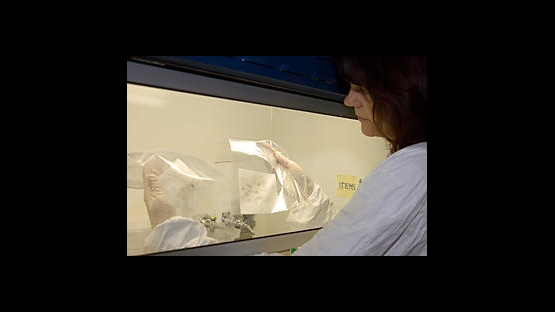As the new year opens, IAEA analysts are hot on the nuclear trail in Iraq. They're probing dust samples from inspected sites in Iraq, looking for atomic fingerprints that could answer -- or raise -- crucial questions. If past is prologue, their findings will be keys to opening a big part of Iraq's nuclear file.
Back in 1991, when IAEA inspectors first uncovered Iraq's clandestine nuclear programme, the discovery was verified by experts at the IAEA's Seibersdorf Laboratories skilled in analyzing environmental samples of nuclear and radioactive materials. From swipes of dust particles, analysts found telltale nuclear signatures indicating secret work to enrich uranium.
More than a decade later, the IAEA's forensic detectives are backing up Iraq inspectors again, this time better equipped and more experienced. Their first results from analyses of high-priority samples are expected in late January 2003, before IAEA Director General Mohamed ElBaradei reports on Iraq inspections to the Security Council. Nuclear inspections are moving into what he describes as the "investigative" phase, and environmental sampling provides a powerful suite of tools.
"We've come a long way since the 1990s," says David Donohue, who heads the Clean Laboratory Unit of the IAEA Safeguards Analytical Laboratory, one branch of the multi-purpose Seibersdorf Labs near IAEA headquarters in Vienna, Austria. "Our Lab is fully operational, with state-of-the-art methods for detecting elements like uranium and plutonium. Newer, more powerful methods are constantly being developed. We can obtain a truly amazing amount of information from a tiny amount of material in samples."
Like prospectors hunting for specks of gold, IAEA analysts rely on experienced eyes and proven methods. Analysis of samples can reveal indicators of past and current nuclear activities, particularly those associated with uranium conversion, fabrication, and enrichment.
"We naturally don't base any final conclusions on a single particle," Mr. Donohue explains. "But we would expect to see a certain number, more than five, if there was an activity carried out with uranium or plutonium."
The IAEA's Lab serves as the centre of a global network of analytical laboratories equipped for the measurement and analysis of nuclear and radioactive materials. Sophisticated tests help analysts screen "swipe samples" that IAEA inspectors collect with small cotton swabs using specialized kits. They swipe walls, floors, or pieces of equipment at inspected sites.
Inside the secure and contamination-free Clean Lab, Donohue and his team screen the samples, using techniques such as X-ray fluorescence and gamma spectrometry, and coordinate the network's analysis of replicate samples. Any uranium and plutonium particles in samples can be detected down to a picogram, or trillionth of a gram. Network Labs involved are in Australia, France, Germany, Japan, Russia, United Kingdom, and the United States. Though the immediate focus is on dust samples, labs are equipped for analyzing various types of environmental samples, including water, soil and vegetation.
The Iraq mission is high priority, but not the Lab's only work. The team of specialists regularly handles hundreds of samples each year from nuclear safeguards inspections that the IAEA conducts at facilities worldwide. Last year, the IAEA carried out safeguards activities at more than 900 facilities in 70 States. For a fuller account of environmental sampling, see Mr. Donohue's article in the forthcoming edition of the IAEA Bulletin.


